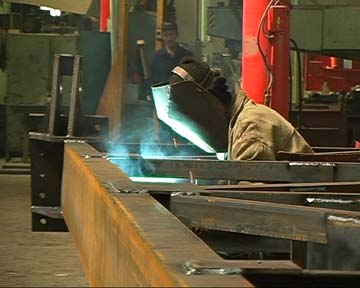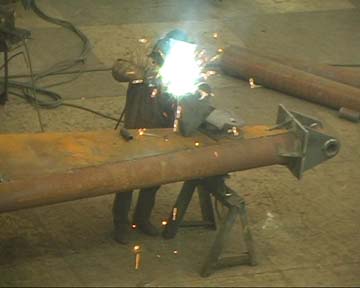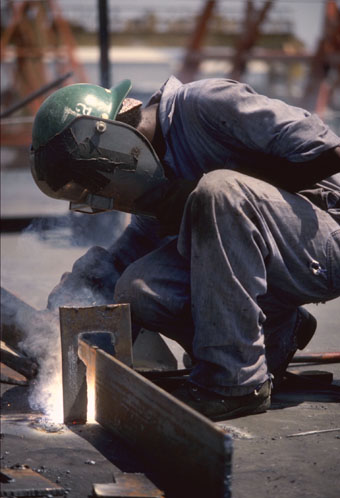Electrical safety in the production of electric welding
Electrical safety requirements for welding equipment
 Electric welding installation (welding transformer, unit, converter, rectifier) must have a passport, operating instructions and an inventory number under which it is recorded in the logbook and periodic inspections.
Electric welding installation (welding transformer, unit, converter, rectifier) must have a passport, operating instructions and an inventory number under which it is recorded in the logbook and periodic inspections.
Transformers, rectifiers and DC generators specially designed for this can be used as welding current sources. Direct feeding of the welding arc from the power (or lighting) distribution network of the workshop is not allowed. Welding sources can be connected to electrical distribution networks with a voltage that does not exceed 660 V. The load of single-phase welding transformers is evenly distributed between the individual phases of a three-phase network.
In mobile electric welding installations, in order to connect them to the network, it is necessary to provide for blocking switches, excluding the possibility of connecting and disconnecting the wire when powering the clamps.
Electric welding installations must be connected and disconnected from the mains, and only electricians should repair them. Welders are prohibited from performing these operations. The length of the first loop between the feed point and the mobile welding unit must not exceed 10 m.
Live parts of the welding circuit must be reliably insulated (insulation resistance must be at least 0.5 MΩ) and protected from mechanical damage. The insulation resistance of the electrical circuits of the installation is measured during routine repairs in accordance with GOST for the operated electric welding equipment. The terms for current and major repairs of welding installations are determined by the person responsible for the electrical equipment of the enterprise, based on local conditions and the mode of operation, as well as the manufacturer's instructions. The unit and its starting equipment should be checked and cleaned at least once a month. All open parts of the welding installation, which is under voltage from the mains, are securely fenced.
Insulation resistance should be checked at least once every three months, and for automatic submerged arc welding, once a month. The insulation must withstand a voltage of 2 kV for 5 minutes.
The housings of the electric welding equipment are neutralized (earthed). For protective grounding (earthing) of the housing, power supplies equipped with special bolts are connected to the conductor of the grounding (grounding) device. In this case, each welding installation must be directly connected to the neutral (ground) wire.It is not allowed to connect installations in series with each other and to use a common neutral (ground) wire for a group of installations. Failure to comply with this requirement can lead to the fact that if the wire connecting the devices in series breaks, some of them will turn out to be non-zero.

Electrical safety rules for welding
According to electrical safety rules, before turning the switch on and off, make sure the body is grounded and the handle is insulated. If there is a breakdown, the switch turns off. Before starting work, it is necessary to arrange the coverall; inspect the workplace, check the serviceability of electric welding equipment, the presence of sealed electrical meters; wipe the floor dry if it turns out to be slippery (washed with oil, paint, water); check the serviceability of the cables, wires and their connections to the welding machine blocks. In the presence of malfunctions, it is forbidden to proceed with electric welding. Care should be taken to keep hands, shoes and clothing dry at all times.
At the end of welding, the electric welder must turn off the welding transformer or generator, disconnect the welding cable with an electric holder, wind the wires into coils and put them in a specially designated place.
Connecting and disconnecting from the network of electric welding installations, as well as monitoring their good condition, must be carried out by electrical personnel with qualification group III at least.

What can be used as a return wire in electric welding
Flexible wires can be used as a return wire connecting the workpiece to the welding power source, as well as, where possible, steel bars of any profile with a sufficient cross-section. The return wire must be insulated in the same way as the one connected to the electrical holder. The use of metal construction structures of buildings, communications and non-welded technological equipment as a return conductor of the grounding network is prohibited.
The individual elements used as a return wire are carefully connected to each other (by welding or using bolts, clamps or clamps). In installations for electric arc welding if necessary (for example, when making circular seams), it is allowed to connect the return wire to the part to be welded using a sliding contact.
Characteristics of electric welding in particularly hazardous conditions
When welding inside metal structures, boilers, tanks, as well as outdoor installations (after rain and snow), the welder, in addition to work clothes, should additionally use dielectric gloves, galoshes and a carpet. When working in closed containers, you should also wear a rubber helmet. In this case, the use of metal shields is prohibited.
Work in closed containers is carried out by at least two people, one of whom must have a qualification group of at least III and be outside the vessel to be welded to supervise the safe conduct of work by the welder. An electric welder working inside the tank is equipped with a safety belt with a rope, the end of which must be with the second person outside.

Limiting the open circuit voltage of the welding transformer
All electric welding installations for manual arc welding with alternating current, intended for welding in particularly hazardous conditions (for example, in metal containers, in wells, tunnels, during normal operation in rooms with increased danger, etc.) must be equipped with voltage limiter idle devices up to 12 V with effective action with time delay no more than 1 s.
